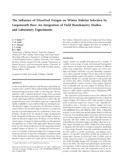The influence of dissolved oxygen on winter habitat selection by largemouth bass: an integration of field biotelemetry studies and laboratory experiments

Metadata
Show full item recordAuthor
Hasler, C. T.
Suski, C. D.
Cooke, S. J.
Tufts, B. L.
Date
2009-01-20Doi
10.1086/591806Citation
Hasler, C. T., C.D. Suski, K. C. Hanson, S. J. Cooke, and B. L. Tufts. "The influence of dissolved oxygen on winter habitat selection by largemouth bass: an integration of field biotelemetry studies and laboratory experiments." Physiological and Biochemical Zoology 82(2) (March/April 2009): 143-152. DOI: http://doi.org/10.1086/591806.
Abstract
In this study, field biotelemetry and laboratory physiology approaches were coupled to allow understanding of the behavioral and physiological responses of fish to winter hypoxia. The biotelemetry study compared dissolved oxygen levels measured throughout the winter period with continually tracked locations of nine adult largemouth bass obtained from a whole‐lake submerged telemetry array. Fish habitat usage was compared with habitat availability to assess whether fish were selecting for specific dissolved oxygen concentrations. The laboratory study examined behavioral and physiological responses to progressive hypoxia in juvenile largemouth bass acclimated to winter temperatures. Results from the dissolved oxygen measurements made during the biotelemetry study showed high variance in under‐ice dissolved oxygen levels. Avoidance of water with dissolved oxygen less than 2.0 mg/L by telemetered fish was demonstrated, but significant use of water with intermediate dissolved oxygen levels was also found. Results from the lab experiments showed marked changes in behavior (i.e., yawning and vertical movement) at less than 2.0 mg/L of dissolved oxygen but no change in tissue lactate, an indicator of anaerobic metabolism. Combined results of the biotelemetry and laboratory studies demonstrate that a dissolved oxygen content of 2.0 mg/L may be a critical threshold that induces behavioral responses by largemouth bass during the winter. In addition, the use by fish of areas with intermediate levels of dissolved oxygen suggests that there are multiple environmental factors influencing winter behavior.
